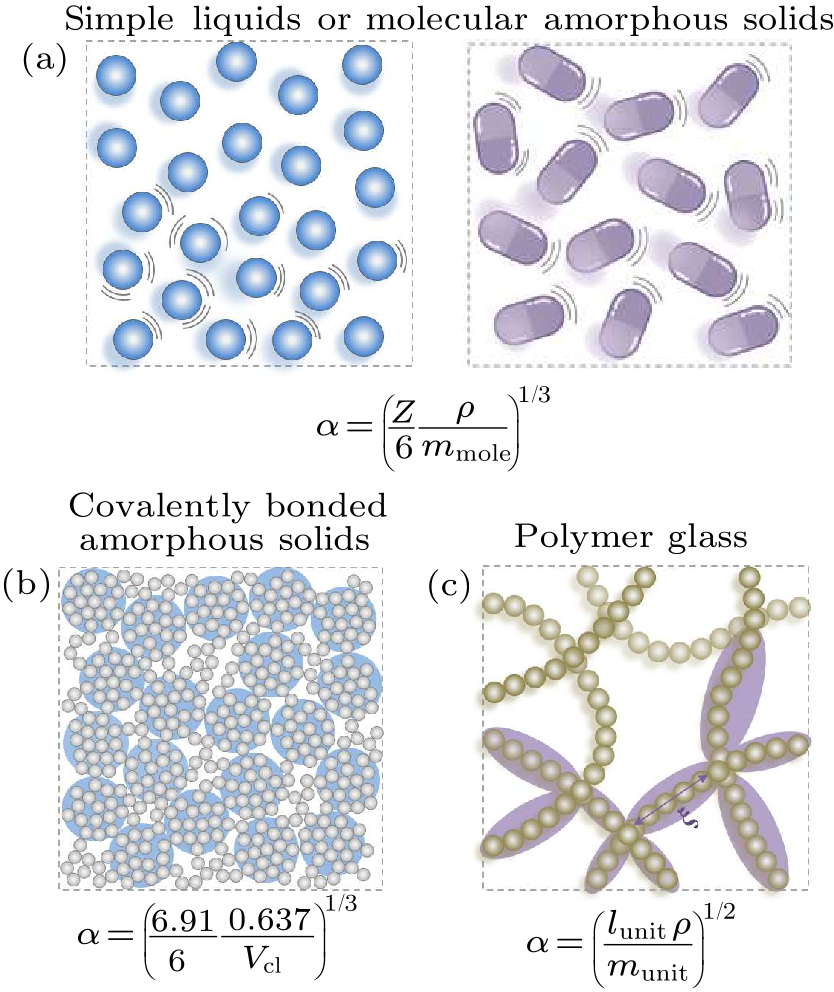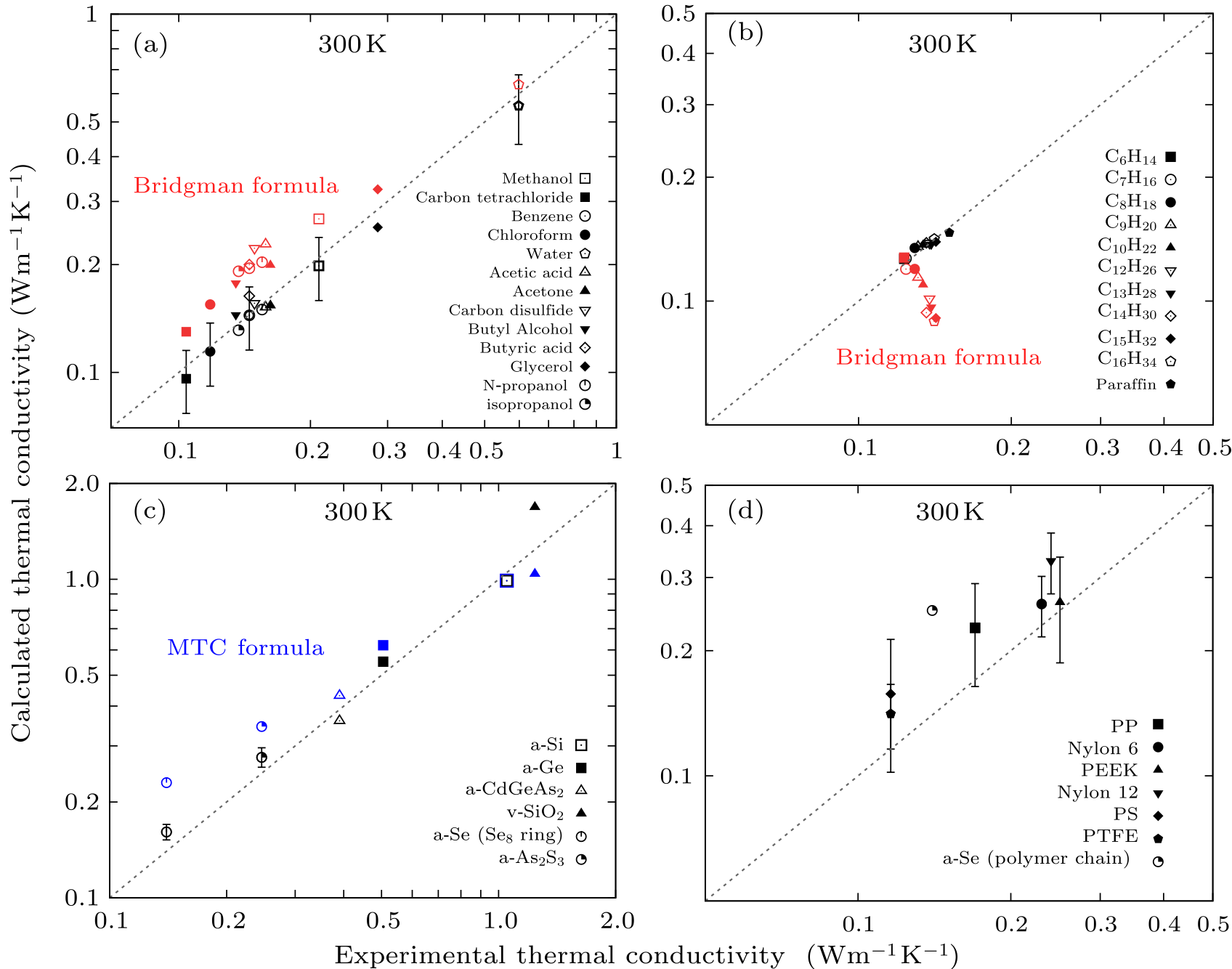| Heat carrier | Thermal conductivity | Ref. | |
|---|---|---|---|
| Gas | Molecule | $\kappa_{\rm G}=\epsilon\eta C_{v}$ | |
| Liquid | Vibration of molecule | $\kappa_{\rm L}=3k_{\rm B}v_{\rm s}n_{\rm mole}^{{2}/{3}}$ | |
| Crystal | Phonon | $\kappa_{\rm C}=\frac{1}{3}C\bar{v}_{\rm s}\Lambda$ | |
| Amorphous solid | Vibration of atom/molecule | $\kappa_{\rm A}=1.2k_{\rm B}\bar{v}_{\rm s}n_{\rm atom}^{{2}/{3}}$ | |
| Polymer | Vibration of molecule | $\kappa_{\rm P}={\left(n_{\rm mole}L \right)}^{{1}/{2}} \frac{1}{R_{\rm inter}}$ | |

Fig. 1. The schematic illustration of different types of fundamental units transferring heat in liquids and amorphous solids and the prefactor $\alpha$ in Eq. (3). (a) The fundamental unit for liquid or molecular amorphous solid is individual molecule. (b) The fundamental unit for covalent amorphous solid is dense cluster (shaded areas in blue). $V_{\rm cl}$ is the volume of atomic cluster. (c) The fundamental unit for polymer is a chain segment (shaded areas in purple).
| Material type | Fundamental unit | $\tilde{n}$ | Typical size | $\varXi $ | $\gamma$ | $D_{\rm v}$ | $\delta$ |
|---|---|---|---|---|---|---|---|
| of fundamental unit | |||||||
| Molecular liquids and solids | Nearly-spherical molecules | $=n_{\rm mole}$ | $a\times a\times a$ | $2 $ | 1 | 1–3 | $= a\approx n_{\rm mole}^{-1/3}$ |
| Molecular liquids and solids | Capsule-like molecules | $=n_{\rm mole}$ | $L\times a\times a$ | $2 $ | 1 | 1 | $\approx a < n_{\rm mole}^{-1/3}$ |
| Molecular liquids and solids | Disk-like molecules | $=n_{\rm mole}$ | $L\times L\times a$ | $2 $ | 1 | 1 | $\approx a < n_{\rm mole}^{-1/3}$ |
| Covalently bonded amorphous solids | Atomic clusters | $\ll n_{\rm atom}$ | $\zeta\times\zeta\times\zeta$ | $2 $ | 1 | 2 | $\approx b < n_{\rm atom}^{-1/3}$ |
| Polymer liquids and solids | Chain segments | $\gg n_{\rm mole}$ | $\xi\times a\times a$ | $4 $ | 1/2 | 1 | $=a^{\prime} \ll n_{\rm mole}^{-1/3}$ |

Fig. 2. Comparison of calculated thermal conductivities from Eq. (3) with experimental ones. The diagonal (dotted) line is given to guide for eyes. Symbol lies on this line means calculated thermal conductivity has the same value with experimental one. (a) Calculated thermal conductivities (black symbols) of thirteen different liquids at 300 K versus the experimental values. $D_{\rm v}$ is chosen to be 1–3 for nearly spherical molecules (methanol, carbon tetrachloride, benzene, chloroform, and water) and $D_{\rm v}=1$ for non-spherical molecules. The experimental data of thermal conductivities are taken from Refs. [2,21] . Thermal conductivities calculated from the Bridgman formula (red symbols) are also given for comparison. (b) Calculated thermal conductivities (black symbols) of ten different alkane liquids and paraffin at 300 K versus the observed values when $D_{\rm v}=1$. The calculated values of $Z$ are listed in Supplementary Information. The experimental thermal conductivities are taken from Ref. [21] . Thermal conductivity calculated according to the Bridgman formula (red symbols) are also given for comparison. (c) Calculated thermal conductivities (black symbols) for six different inorganic amorphous solids at 300 K versus the observed values when $D_{\rm v}=2$ except for a-As$_{2}$ S$_3$ and a-Se, in which case we take As$_{2}$ S$_3$ and Se$_8$ molecules as fundamental units with $5 < Z < 7$ and $D_{\rm v}=1$. The experimental thermal conductivities are taken from Ref. [11] . Thermal conductivity calculated using the MTC formula (blue symbols) are also given for comparison.[11] (d) Calculated thermal conductivities (black symbols) for six polymers and a-Se composed of 100$\%$ polymeric chains at 300 K versus the experimental values when $D_{\rm v}=1$. The experimental data are taken from Ref. [22] .
| [1] | Loeb L B 1927 Kinetic Theory of Gases (New York: McGraw-Hill Book Co., Inc.) |
| [2] | Bridgman P W 1923 Proc. Am. Acad. Arts Sci. 59 141 | The Thermal Conductivity of Liquids under Pressure
| [3] | Lin S H, Eyring H and Davis W J 1964 J. Phys. Chem. 68 3017 | Thermal Conductivity of Liquids
| [4] | Powell R E, Roseveare W E and Eyring H 1941 Ind. Eng. Chem. 33 430 | Diffusion, Thermal Conductivity, and Viscous Flow of Liquids
| [5] | Kittel C 2005 Introduction to Solid State Physics 8th edn (New York: John Wiley & Sons) |
| [6] | Debye P J W 1914 Vorträgeüber die Kinetische Theorie der Materie und der Elektrizität (Leipzig: Teubner B G) |
| [7] | Peierls R 1929 Ann. Phys. 395 1055 | Zur kinetischen Theorie der Wärmeleitung in Kristallen
| [8] | Kittel C 1949 Phys. Rev. 75 972 | Interpretation of the Thermal Conductivity of Glasses
| [9] | Van Krevelen D W and Te Nijenhuis K 2009 Properties of Polymers 4th edn (Amsterdam: Elsevier) |
| [10] | Cahill D G and Pohl R O 1989 Solid State Commun. 70 927 | Heat flow and lattice vibrations in glasses
| [11] | Cahill D G, Watson S K and Pohl R O 1992 Phys. Rev. B 46 6131 | Lower limit to the thermal conductivity of disordered crystals
| [12] | Xie X, Yang K, Li D, Tsai T H, Shin J, Braun P V and Cahill D G 2017 Phys. Rev. B 95 035406 | High and low thermal conductivity of amorphous macromolecules
| [13] | Einstein A 1911 Ann. Phys. 340 679 | Elementare Betrachtungen über die thermische Molekularbewegung in festen Körpern
| [14] | Zallen R 1998 The Physics of Amorphous Solids (New York: John Wiley & Sons) pp 107, 133 |
| [15] | Zhou J, Xi Q, He J, Nakayama T, Wang Y Y and Liu J 2020 Phys. Rev. Mater. 4 015601 | Thermal resistance network model for heat conduction of amorphous polymers
| [16] | Simoncelli M, Marzari N and Mauri F 2019 Nat. Phys. 15 809 | Unified theory of thermal transport in crystals and glasses
| [17] | Stachurski Z H 2015 Fundamentals of Amorphous Solids: Structure, Properties (Beijing: Higher Education Press) pp 23, 116 |
| [18] | Liu Z, Wu X, Yang H, Gupte N and Li B 2010 New J. Phys. 12 023016 | Heat flux distribution and rectification of complex networks
| [19] | Xiong K, Liu Z, Zeng C and Li B 2020 Natl. Sci. Rev. 7 270 | Thermal-siphon phenomenon and thermal/electric conduction in complex networks
| [20] | Nakayama T, Yakubo K and Orbach R L 1994 Rev. Mod. Phys. 66 381 | Dynamical properties of fractal networks: Scaling, numerical simulations, and physical realizations
| [21] | Yaws C L 1995 Handbook of Thermal Conductivity (Houston: Gulf Publishing Company) vol 1–3 |
| [22] | Mark J E 2009 Polymer Data Handbook (Oxford: Oxford University Press) |
| [23] | Alexander S 1998 Phys. Rep. 296 65 | Amorphous solids: their structure, lattice dynamics and elasticity
| [24] | Trachenko K and Brazhkin V V 2013 Sci. Rep. 3 2188 | Duality of liquids
| [25] | Frenkel J 1947 Kinetic Theory of Liquids (Oxford: Oxford University Press) |
| [26] | Dyre J C 2006 Rev. Mod. Phys. 78 953 | Colloquium : The glass transition and elastic models of glass-forming liquids